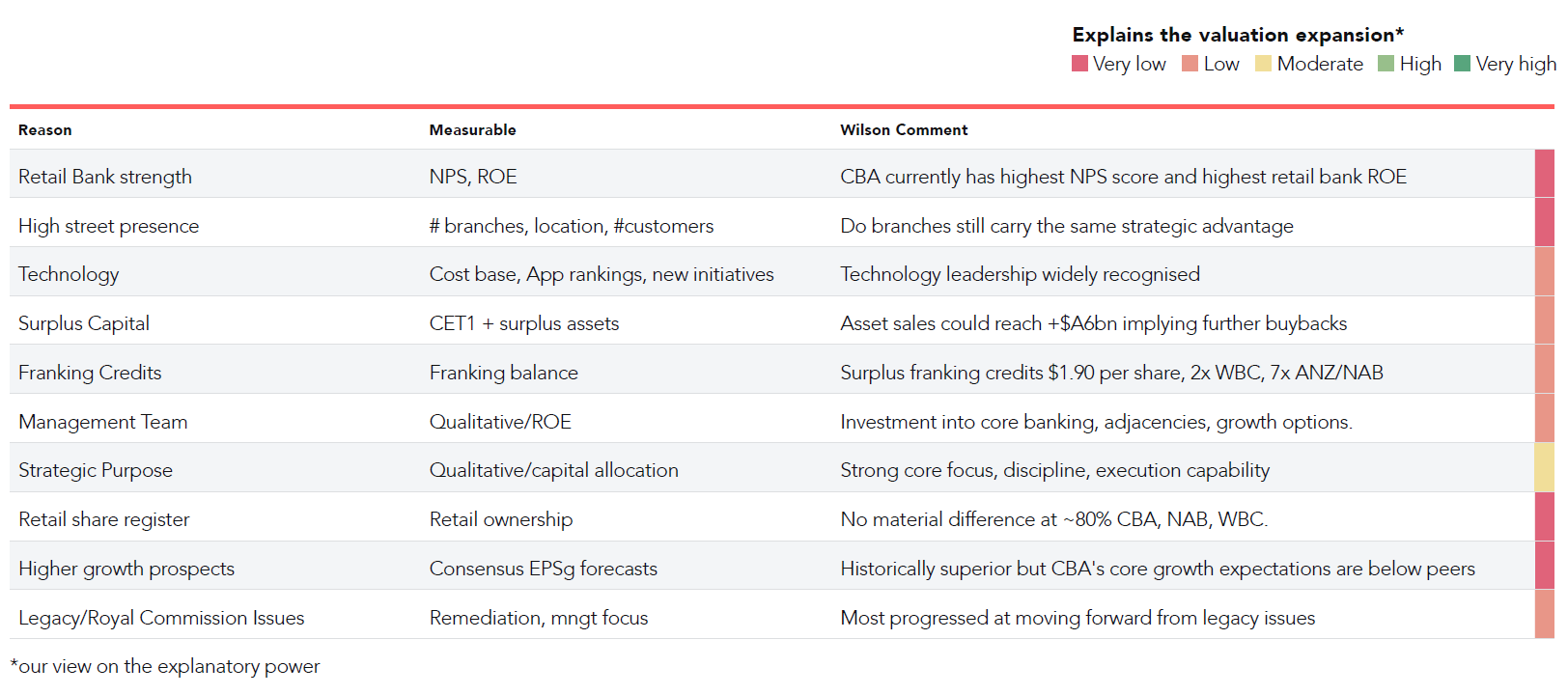Why we think CBA’s premium has peaked

Wilsons Advisory
Across three decades the market has valued Commonwealth Bank (ASX:CBA) - Australia’s largest bank - at a premium relative to its three peers. Whether we look at earnings, dividends or book measures of valuation, CBA has consistently traded at a 15-20% premium since the 1990s.
CBA's premiums are currently 2-3x higher than what we have seen over the past 20 years. Analysts across the market cannot make sense of this expanded premium, which began to emerge in 2019. CBA today is the only Refinitiv consensus Sell-rated (since August 2020) bank amongst the big four. And it goes further, with CBA having more analyst Sell ratings than all three peer banks combined.
Whilst CBA’s premium valuation seemingly defies gravity; there are valid reasons to suggest a premium rating is warranted. CBA’s higher return on equity, dominant retail bank, technology leadership, and a track record of a more consistent operating performance are all valid reasons.
The key question remains, why is this premium higher than at any other time in CBA's history? We have recently reduced our bank sector call to underweight, given a more balanced prospect between earnings growth and valuation.
Our preferred exposures of National Australia Bank (ASX:NAB), Westpac (ASX:WBC) and ANZ (ASX:ANZ) all play to an earnings and execution improvement story. All trade on much lower valuation measures vs CBA. We also prefer niche player Judo Capital Holdings (ASX:JDO), given the prospects for rapid market share growth in business lending.
Exhibiting CBA’s Premium Rating
CBA is the most recent of the big four banks to float in 1991. This marked the passage from the government to public ownership of CBA. It did not take long for the signs of a premium rating to emerge in the mid-1990s, only 5 years after the company was listed.
Exhibit 1: CBA PE premium to peers increased significantly post Banking Royal Commission

Source: Refinitiv, Wilsons.
In the late 1990s and early 2000s, both price-to-earnings (PER) and price-to-book (P/B) showed a clear premium. The size of CBA’s premium multiple has become more pronounced post-GFC, with a 15- 20% PER premium vs peers emerging. This level of premium remained relatively steady from 2006/07, through to the Banking Royal Commission ending in 2018/2019.
Exhibit 2: CBA P/B premium has also expanded noticeably post-Banking Royal Commission

Source: Refinitiv, Wilsons.
Post Banking Royal Commission, the size of CBA’s PER premium has risen to almost 50%, whilst on a P/B basis, the premium is closer to 70%. In both cases a clear expansion has occurred since 2019.
CBA’s premium rating is not just on display through valuation measures. The CBA share price has also been the highest performing of the major banks since 1990, with a total return almost double what second-placed ANZ has generated. It is notable that the outperformance differential has accelerated post-GFC.
Exhibit 3: CBA share price significantly outperformed peer banks, particularly post-GFC

*Total return indexed at 100 Jan1991. Source: Refinitiv, Wilsons.
Three Reasons Behind CBA’s Premium
CBA’s asset base is broadly the same size as peer banks at ~$A1tr in size (interestingly, CBA has not always been the largest bank by total assets over the past 5 years). Yet despite the similar size of asset bases, CBA consistently earns ~$8-9bn of annual earnings vs peers in the $6-7bn range.
Exhibit 4: Despite similar size asset bases, CBA earned +30% more in FY21. Market cap close to double the size of peers

Source: Refinitiv, Wilsons.
1. Balance sheet leverage
Bank equity is essentially a play on the size of a bank’s loan book (or assets) and the level of return those assets can generate. The level of return that can be generated is primarily determined by the embedded leverage within a bank’s balance sheet.
It may come as a surprise that CBA has typically run a higher leverage ratio than its peers, holding both lower reserves and liquidity.
This is critically important, as when your balance sheet is leveraged ~15x, it is this aspect of a bank’s design that has a more meaningful impact on returns rather than management influence.
To be sure, management can provide overlays on who to lend to, and who to avoid. Still, the level of leverage is ultimately the key factor in determining the earnings of a bank (that and survivability!).
A bank’s reserve ratio measures the bank’s level of liquid assets (cash, short-term government bonds) to deposits. The temptation for a bank is to run lower reserve levels freeing up assets for additional loans, which is fine until loans begin to go bad. Relative to NAB, CBA has always held a much lower level of reserves. In other words, CBA has run a more aggressive balance sheet vs NAB.
Exhibit 5: CBA reserve ratio has consistently been lower than NAB

Source: Refinitiv, Wilsons.
On liquidity, it is a similar story. CBA has been more aggressive than NAB over the past 30 years, holding a lower level of liquid assets relative to the bank’s total asset base. This allows for additional capital to be lent out to earn a return. Of course, holding lower liquid assets needs to be treated carefully, as running out of cash is a terminal event for a bank.
Exhibit 6: CBA has held a lower liquidity ratio vs NAB, which is a more aggressive approach to risk management

Source: Refinitiv, Wilsons.
2. Earnings growth
The more aggressive balance sheet settings for CBA have been successful to date, with CBA generating a superior level of earnings growth over the past 15 years. The magnitude of earnings outperformance, double that of second-placed ANZ, also speaks volumes about how CBA has gone about its business over the years. Higher leverage, but with a sharper, more consistent focus.
EPS is, of course, a function of both earnings and share count. CBA, along with ANZ, have been the most disciplined of the major banks in issuing shares. Since 2010, ANZ and CBA have increased their share count by 15% and 17%, respectively. In contrast, WBC has risen by 31% and NAB by 64%. Unless cancelled or bought back, an increase in share count is a permanent headwind for EPS growth.
Exhibit 7: CBA’s EPS growth has been vastly superior to its peers

Source: Refinitiv, Wilsons.
Looking forward, pre-provision profit growth across the major banks is expected to average 8% over FY22- FY24E as some of the cost savings take effect. CBA is expected to lag at just 3%, well behind the 11-12% of both NAB and WBC which are in repair and rebuild mode.
3. Excess returns of capital
CBA’s ability to generate higher earnings whilst limiting the level of share issuance has resulted in a higher return on equity. Over the past 30 years, CBA’s ROE has been 2-3 percentage points higher than peer banks.
Exhibit 8: CBA has consistently generated an excess return on equity vs peers*

Source: Refinitiv, Wilsons
The ability of CBA to more consistently and more efficiently (less capital intensive) generate returns is ultimately the key reason why CBA’s equity commands a premium relative to peers.
Arguments for CBA's extended valuation premium
We have accessed a number of the common arguments put forward by investors to explain CBA’s premium multiple, and in short, are left unconvinced they adequately explain the valuation expansion.
Exhibit 9: Our take on the arguments for the expanded CBA valuation premium
Click to enlarge

Source: Refinitiv, Wilsons.
Is CBA’s Premium Rating Sustainable?
This is the key question for investors. With such a large expansion in the valuation premium since 2019, can the current level be maintained or does mean revision set in at some point?
Ultimately, we side with a view that elevated valuation multiples of CBA will face a mean reversion challenge – typically brought on via an unexpected misstep or crisis within the bank. These events are, by nature, difficult to forecast.
Even the best performing banks lose operational momentum and investor enthusiasm from time to time. This week’s 1Q22 update from CBA, which implied a collapse in CBA’s net interest margin during the quarter, could well be the trigger for investors to reassess CBA’s premium multiple.
The relative premium of CBA vs peers could also narrow by peer bank share prices outperforming. All three peer banks are arguably in a state of repair and renovation, with investors still questioning (as implied by depressed valuations) whether the current strategies will deliver durable ROE improvement.
Of CBA’s three peers, we see NAB showing the most convincing early signs that its operational momentum can lift its ROE.
NAB is our preferred major bank. The outsized CBA valuation premium is hard to justify on the basis of the fundamental outlook. We see a real risk that the valuation premium erodes to a more modest level over the medium-term.
Exhibit 10: CBA's forward earnings outlook is now well below peers

Source: Refinitiv, Wilsons.
Realise your ambition
At Wilsons, we think differently and delve deeper to uncover a broad range of interesting investment opportunities for our clients. Stay up to date with all my Australian Equity insights by hitting the follow button below.
1 topic
5 stocks mentioned

John Lockton joined Wilsons in 2010 as Senior Investment Strategist and has more than 20 years’ experience in investment markets. His primary areas of focus are equity strategy, security analysis and portfolio management. John is the Head of...
Expertise

John Lockton joined Wilsons in 2010 as Senior Investment Strategist and has more than 20 years’ experience in investment markets. His primary areas of focus are equity strategy, security analysis and portfolio management. John is the Head of...
